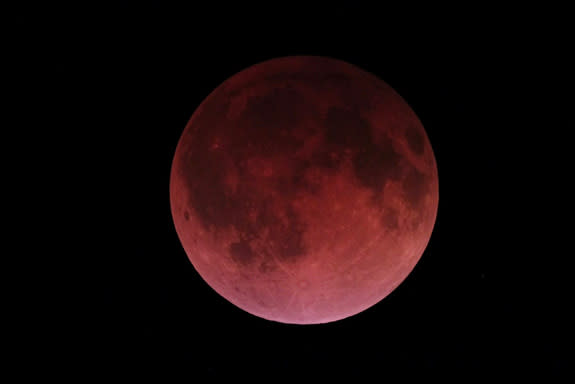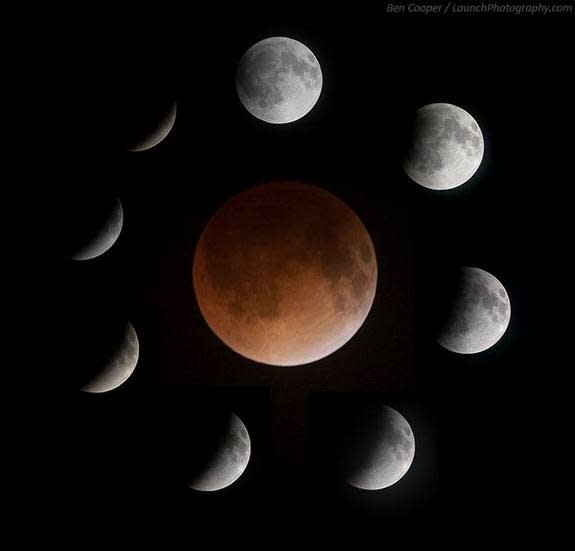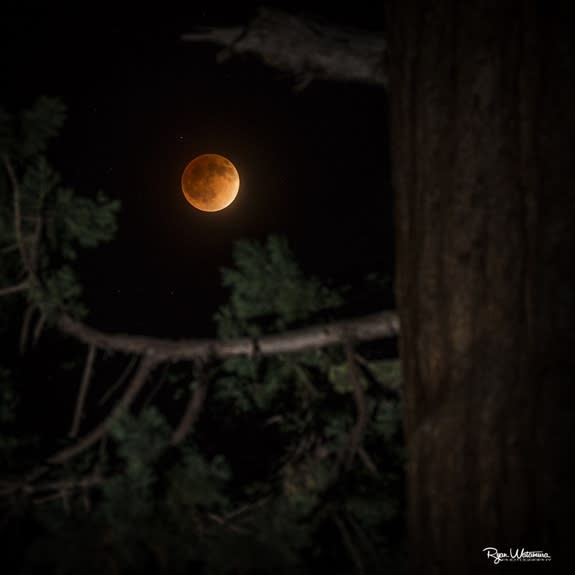Blood Moon Photos: Spectacular Total Lunar Eclipse Views by Stargazers (Video, Images)
Stargazers across the United States were awed by last night's total eclipse of the moon, and they've got some amazing photos to prove it.
Observers in a North America, South America, Hawaii and parts of Alaska got a spectacular show as the moon turned blood red during the first total lunar eclipse of 2014. While the weather wasn't great for everyone in the path of the total eclipse, some stargazers got a break from the clouds to capture the celestial sight during the 3.5 hours it was visible. You can also watch a time-lapse video of the "Blood Moon" rising on Space.com.
"We lucked out on the weather, as skies were mostly cloudy during the afternoon and evening, and even during the eclipse we were viewing through a thin layer of cirrus much of the time," veteran rocket launch photographer Ben Cooper told Space.com via email of his Florida eclipse-viewing experience. While Cooper may have seen the eclipse through clouds, his mosaic photo is a standout. It features a blood red moon in the center of the image framed by the various stages of the lunar eclipse. [See more photos of the first total lunar eclipse of 2014]
This kind of lunar eclipse is sometimes known as Blood Moon because the sunlight scattered by Earth's atmosphere casts a red pall on the face of the moon.
"Tonight's lunar eclipse was an unforgettable experience for me," Arizona-based cinematographer Sean Parker told Space.com via email. "It was such a great sight to see."
The April 14-15 total lunar eclipse was also paired with another stellar sighting. The bright star Spica in the constellation Virgo was positioned to the right and below the moon. Spica's bright bluish light would have been even more pronounced as the moon darkened during the eclipse.
Just before the eclipse, Mars made its closest approach to Earth since 2008. The Red Planet passed within 57.4 million miles (92.4 million kilometers) of Earth, giving the moon a Martian companion during the night.
Some astrophotographers were able to capture the moon, Mars and Spica in the same frame.
"Very beautiful event," photographer Victor Rogus told Space.com via email. He sent in his view of the eclipse, Spica and Mars from Jadwin, Mo. "Clouds parted just in time, thank you!"
Some photographers blended Earth's natural beauty with the lunar eclipse by choosing the perfect spot for a celestial viewing. Photographer Ryan Watamura, for example, captured the eclipse from Grant's Grove in Kings Canyon National Park in California. His photos frame the copper-colored moon with the majestic trees of Grant's Grove.
Lunar eclipses occur when the moon is full and passes behind the Earth, with respect to the sun, and is obscured by the planet's shadow. Total lunar eclipses happen when the moon is totally covered by Earth's shadow, darkening its typically bright face.
The April total lunar eclipse also kicks off a so-called "tetrad" of four consecutive total lunar eclipses between now and September 2015. The next total lunar eclipse will occur on Oct. 8 and should also be visible from much of North America.
Later this month, from April 28 to April 29, the sun will turn into a "ring of fire" during an annular eclipse. That solar eclipse, however, will only be visible from an uninhabitated part of Antarctica, so it is possible that only be penguins can see it.
Editor's Note: If you snapped an amazing picture of the April 15 total lunar eclipse, you can send photos, comments and your name and location to managing editor Tariq Malik at spacephotos@space.com.
Follow Miriam Kramer @mirikramer and Google+. Follow us @Spacedotcom, Facebookand Google+. Original article on Space.com.
Best Telescopes for Beginners | Telescope Reviews & Buying Guide
The Night Sky in 2014: 11 Must-See Celestial Events (Infographic)
Copyright 2014 SPACE.com, a TechMediaNetwork company. All rights reserved. This material may not be published, broadcast, rewritten or redistributed.

 Yahoo News
Yahoo News 


